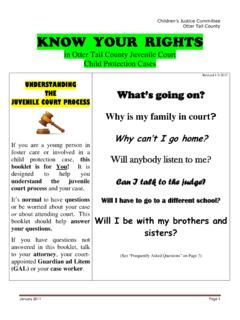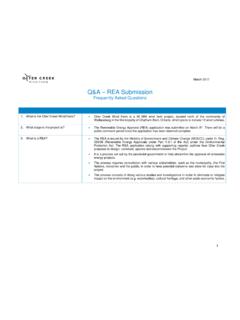Transcription of Frequently Asked Questions - Fort Ord
1 Introduction Army, Fort Ord BRAC Frequently Asked Questions Munitions Cleanup: Fort Ord National Monument (Northern Portion) Fort Ord Community Relations Office: 1-800-852-9699, or go to May 2017 Page 1 This fact sheet addresses Frequently Asked Questions about roads and trail access while the Army conducts a munitions cleanup in the northern portion of the Fort Ord National Monument. The Army calls this munitions cleanup area Bureau of Land Management Area B or BLM Area B, for short. It is about 800 acres and located north of the former Impact Area. The Army and the Bureau of Land Management are committed to providing a safe parkland for visitors, workers, and wildlife on the former Fort Ord. Munitions investigations in the northern portion of the national monument have prompted additional cleanup work that will proceed in stages for several years.
2 The cleanup could temporarily affect access to the road and trail systems that were previously open for public recreation use since 1996. Visitors who comply with posted restrictions and remain on designated trails are safe from munitions hazards. We ask that you Mind the Signs. This is an important area for many recreational users. Key cleanup goals include: comply with the Record of Decision prepare land for safe management and use as the Fort Ord National Monument keep the community safe during cleanup work complete cleanup safely and quickly SCHEDULE and ACCESS Page 2 HOW CAN I GET INFORMATION ABOUT ROAD AND TRAIL CLOSURES AND CLEANUP ACTIVITIES IN THIS AREA? Current road and trail closures can be found at and the Army s information line at 1-800-852-9699. WHY DO THE ROADS AND TRAILS NEED TO BE CLOSED? Army safety regulations require that public safety exclusion zones be maintained during munitions and explosives of concern (MEC) cleanup work activities.
3 The types of activities that require public safety exclusion zones include vegetation cutting, prescribed burning, and MEC removal. The exclusion zones protect the public from flying debris from mechanical vegetation cutting and explosives operations. WHEN AND HOW LONG WILL TRAIL CLOSURES BE IN EFFECT? The time particular trails may be closed is dependent upon the field activities that require an exclusion zone. The Army strives to avoid prolonged closures, and will reopen the roads and trails as soon as possible. For the latest information on access to areas in the northern portion of the Fort Ord National Monument, go to our website: For a brief verbal description of trail closures, please call 1-800-852-9699. WILL THE ENTIRE AREA BE CLOSED OR CAN SOME AREAS BE LEFT OPEN AS THE CLEANUP IS CONDUCTED? The Army has subdivided the munitions cleanup area into segments so that temporary trail closures can be limited to areas where work is occurring.
4 Affected trails will be reopened for public use after the cleanup is complete in the work area. CAN THE ROADS AND TRAILS BE USED ON WEEKENDS AND EVENINGS? To further reduce impacts to recreational use and to facilitate transit to and from parts of the northern portion of the Fort Ord National Monument, the Army has identified access corridor roads that will be kept open during evenings and weekends. The access corridor roads are identified in maps on the project website WILL CLOSURES AFFECT THE SEA OTTER CLASSIC OR OTHER EVENTS HELD IN THE NORTHERN PORTION OF THE FORT ORD NATIONAL MONUMENT? The Army works closely with other property owners and event organizers when its environmental cleanup actions could affect them. The Army is coordinating with Bureau of Land Management to adjust trail closures, when possible, to accommodate Bureau of Land Management events.
5 HOW LONG WILL THE PROJECT TAKE? A rough estimate for project completion is 3 or more years. Completion is dependent on many variables including the ability to conduct prescribed burns. The Army s goal is to complete the cleanup in the northern portion of the Fort Ord National Monument as quickly as possible and to reopen the land to recreational use. WILL SOME POPULAR TRAILS BE CLOSED FOR MANY YEARS? The sooner the Army can finish the cleanup the sooner the closures will end. If we are able to complete the work as planned, including prescribed burning which is weather dependent, work should be complete in several years. In the interim, please Mind the Signs. Visitors who comply with the posted restrictions and remain on designated trails are safe from munitions hazards. HOW CAN WE ENJOY THE FORT ORD NATIONAL MONUMENT DURING THE MUNITIONS CLEANUP?
6 We ask that you Mind the Signs. When you are planning a trip into this area, please check the Cleanup Programs section of the Army s website or call 1-800-852-9699 to see if there are any road or trail closures related to cleanup work. Page 3 Army, Fort Ord BRAC VISITOR SAFETY WHAT IF I FIND A POSSIBLE MUNITIONS ITEM? Please follow the 3 R s of explosives safety: Recognize, Retreat, and Report. Call 911. THE MONTEREY OFF ROAD CYCLING ASSOCIATION (MORCA) CONDUCTS TRAIL MAINTENANCE WORK ON A VOLUNTEER BASIS. WORK MAY INVOLVE SHALLOW GROUND DISTURBANCE SUCH AS 3 INCHES. DOES THAT COUNT AS A SUBSURFACE ACTIVITY THAT REQUIRES CONSTRUCTION SUPPORT? The answer is yes. Construction safety support is a requirement for any ground disturbing or intrusive activities within the northern portion of the former Fort Ord National Monument. The Army will continue coordination with the Bureau of Land Management for the safe care of the monument.
7 All volunteer work on trails must be coordinated with the Bureau of Land Management to ensure public safety. WHAT DOES "SURFACE REMOVAL" MEAN? Surface removal means that all visible suspected munitions and munitions debris will be removed from the ground surface. Vegetation must be cut or burned to make the ground safe and visible for MEC removal teams to conduct this work. Explosive items will be destroyed by detonation. WILL THE ARMY CUT TREES? WILL BURNING DAMAGE TREES? In munitions cleanup areas vegetation will be cut or burned to expose the ground for munitions removal. Trees are not typically cut. In oak woodland areas, trees greater than four inches in diameter will be limbed up to eight feet to allow access for surface removal. Though trees are not targeted for burning, if they are burned they usually survive. Chaparral will be cleared by prescribed burning when feasible.
8 WHY MUST THE ARMY BURN IN THE FORT ORD NATIONAL MONUMENT? Prescribed burning is the primary method for clearing chaparral vegetation to conduct munitions cleanup. Burning is also needed to sustain and enhance the chaparral plant community and is consistent with both the Fort Ord Habitat Management Plan and the Biological Opinion issued by Fish and Wildlife Service. Prescribed burns will be conducted in a manner similar to those in the former Impact Area. They are conducted under strict burning conditions including very specific meteorological conditions. The Army will provide public notification of planned prescribed burns. MUNITIONS CLEANUP Planning a trip into the BLM Area B Work Area? Check out the Army s website, , to receive the current trail status. Access corridor roads will be closed within the exclusion zones during work, but will remain open the rest of the time to allow for passage through the Monument.
9 Page 3 Page 4 Land Management to provide a safe parkland for visitors, workers, and wildlife. HOW CAN I LEARN MORE ABOUT THE FORT ORD MILITARY MUNITIONS RESPONSE PROGRAM:? Army Fort Ord Base Realignment and Closure Office; William Collins, BRAC Environmental Coordinator, 1-831-393-1284, Environmental Protection Agency, Region 9; Maeve Clancy 1-415-947-4105, California Environmental Protection Agency, Department of Toxic Substances Control; Vlado Arsov, 1-916-255-4988, IS THERE ANYTHING I CAN DO TO ENSURE THE PROJECT IS COMPLETED WITHIN THE PROPOSED TIMEFRAME? Familiarize yourself with the currently open trails and routes. Trespassing and vandalism in restricted areas will only slow down the cleanup progress. Be sure to Mind the Signs and only use trails that are open. WHAT WILL THE ARMY DO TO PRESERVE THE CHARACTER OF THE TRAILS?
10 The Army recognizes the temporary loss of trail access as a concern as well as the change to the character of trails. This will be taken into consideration as part of the work planning process. For example, some trees may be limbed up rather than removed. The Army is working closely with the Bureau of Land Management who will maintain the trail network for public enjoyment. HASN'T THE ARMY ALREADY INVESTIGATED AND EVALUATED THIS AREA A LONG TIME AGO? The current Bureau of Land Management properties were transferred in 1996. Army investigations were conducted at that time. Subsequent studies concluded additional cleanup is warranted in portions of the northern portion of the former Fort Ord National Monument to support long-term use of the land as a habitat reserve. Visitors who comply with the posted restrictions and remain on designated trails are safe from munitions hazards.









